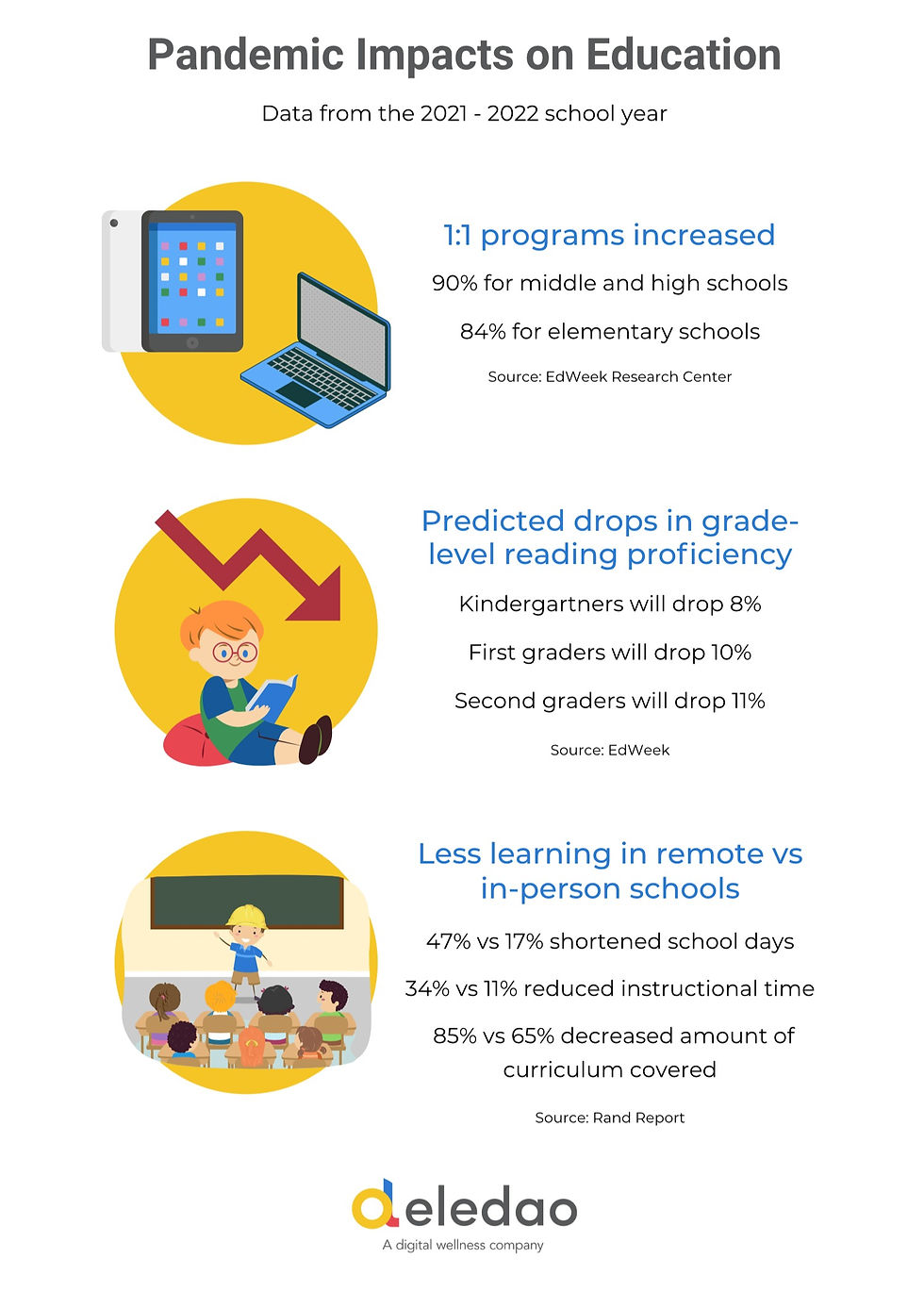Pandemic Learning Loss and Achievement Gaps: How K12 Technology Shapes Recovery
- Kevin Kuckkan, M.Ed.

- May 16, 2022
- 4 min read
Updated: Oct 19
The 2021-22 school year represented perhaps the closest to a ‘typical’ school year that K12 has experienced in three years. Face-to-face instruction resumed, students returned to the normal rhythm of school-related activities, and, generally speaking, life returned to some semblance of normalcy.
While K12 continues to adapt, an opportunity to reflect on some of the changes presents itself.
This article is the first in a series of three articles that will examine insights and takeaways, learnings, impacts, and challenges that have emerged post-pandemic in K12.

1:1 Devices Nearly Doubled During the Pandemic
Prior to the pandemic, K12 was certainly moving toward higher percentages of districts providing devices for every student. 23% of surveyed districts had achieved a 1:1 device ratio, according to a 2014 COSN survey. Data from the National Center for Education Statistics shows that 1:1 programs nearly doubled five years later, rising to 45% during the 2019-2020 school year before the pandemic.
Despite the growth in 1:1 deployment, schools controlled the pace by making incremental steps. Most envisioned that achieving greater than 90% in 1:1 programs was more than likely within the decade. Yet, seemingly overnight, the pandemic dramatically altered the 1:1 deployment pace.
A March 2021 EdWeek Research Center survey of teachers showed that the percentage of students issued devices by their districts had risen to 90% for middle and high school students and 84% for elementary-age students. The start of the 2021-2022 school year found more students on school-issued devices than at any other time in our nation’s history.
Student achievement fell around 50% during the pandemic
Student achievement suffered during the pandemic, but how deep and significant are those losses? Post-pandemic data on grade-level reading proficiency is rather sobering. EdWeek reports that research shows the most significant grade-level reading proficiency drops in grades K-3.
2021-2022 overall school year-end trends
Using the widely adopted standardized reading skill measurement tool, Dynamic Indicators of Basic Early Literacy Scores (DIBELS), the following 2021-2022 year-end trends are seen for emerging and early readers:
Kindergartners are predicted to drop from 55% to 47%
First graders are predicted to drop from 58% to 48%
Second graders are predicted to drop from 59% to 48%

The same research projects that more than 1/3 of all U.S K-3 grade students will be identified as needing intensive reading intervention or related support by the end of the 2021-2022 school year.
Declined 3rd grade literacy rates
As has been widely researched and documented, third-grade literacy serves as an educational barometer in predicting potential student success in subsequent years. Research from The Children’s Reading Foundation suggests that 74% of struggling readers won’t ever catch up by the end of third grade.
Furthermore, The Campaign for Grade-Level Reading reports that third graders reading below proficiency fail to graduate four times that of on-grade-level readers. For those third-grade readers unable to master the most basic, foundational reading skills, that rate jumps to six times that of on-grade-level readers. Based on this and other corroborating research, on-grade proficiency levels for third graders is a reliable metric in predicting student success.
While on-grade reading proficiency levels prior to the pandemic weren’t exemplary, near double-digit reductions in the percent of students anticipated to be reading at grade level certainly presents a challenge for K12 to address.

2 Main Factors Why Student Performance Declined
Undeniably, those in K12 did the best they could in an arguably difficult situation as the influx of ed tech resources was pumped into schools across the country. Though a number of factors directly impacted student success in remote or hybrid environments, two key instructional factors:
1) Lost instructional time
15% of mostly remote teachers reported covering all or nearly all of the curriculum they’d cover in a typical school year, compared to 35% for mostly in-person teachers.
2) Shorter school days
According to a recent Rand report:
47% of mostly remote schools reported shortening school days compared to 17% of their mostly in-person counterparts.
34% of mostly remote schools reported a reduction in instructional time, compared to 11% for mostly in-person students.
Depending upon whether their school was mostly remote or mostly in-person, the data suggests that students were clearly on markedly different learning pathways during the pandemic-altered instructional period. As a whole, reductions in school day length, instructional time, and content coverage suggest that rigor and depth of coverage were less in mostly remote settings than in their in-person counterparts.

How Schools Are Responding to Declining Performance
Staff Training
Perhaps recognizing that there’s room for improvement, 69% of surveyed district leaders from the same study believe that teachers need further training when it comes to effective digital learning practices.
Personalized Learning
Driven in part by the achievement drops, districts nationwide implemented alternative schedules to provide more intensive support for students in need. These implementations utilize the expansion of 1:1 to deliver personalized learning initiatives to individual students.
Obstacles most certainly lie ahead, yet forward-thinking administrative teams combined with like-minded instructional and educational technology innovators will continue to play a significant role in helping K12 close these gaps. School leadership teams can directly impact classrooms by providing instructional teams with the tools they need to keep students engaged on school devices on and off campus.
AI-Powered Classroom Management
Many districts switched to Deledao ActiveInstruct™, an AI powered Classroom Management Solution that filters out distractions in real-time. It also monitors student wellbeing for teachers and IT admins.
As one component of a more comprehensive digital literacy or digital citizenship solution, Deledao’s patented technology is helping schools keep students safe, protected, and engaged while using their school devices.



